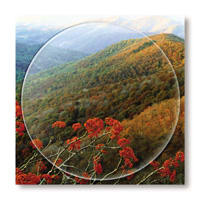How I...
Sell photochromics to
septuagenarians
By Erinn Morgan
With a 12-person team of ophthalmologists, The Center for Eyecare Excellence in Miami caters to patients ranging in age from one week to 104. However, at least 25 percent of this successful practice's patient base is age 70 and up. "I handle most of the geriatric patients," says Henry Trattler, MD. "My niche has always been the senior citizen. Here, we don't consider someone 'old' until they are in their 90s."
With elderly patients leading more active retirement years, Trattler says he sees a need and demand for photo-chromics, usually in progressive lens designs. "About 20 percent of our patient base gets photochromics now. I think that the national advertising that's gone on for these lenses does make a difference. When you put things in a magazine or on television it makes an impact. You have to put a bee in the patient's bonnet."
However, for the 70-plus crowd, it apparently does not take too many bees to make photochromics a priority. "I think they are easier to deal with because there is more of a concern for health as you get older," says Trattler. "The older patients are more health-conscious and willing to spend money on their health. They look at $300 to $400 for a pair of glasses as small compared to the thousands of dollars they spend on other health care concerns."
|
|
|
|
Hoya's photochromic is now available in the new Trivex material |
|
POSITIONING PHOTOCHROMICS
Even though seniors are more open to the photochromic add-on--The Center for Eyecare Excellence charges $60 to $80 for the option--this practice employs a variety of methods to ensure proper patient education to assist them in making this important decision.
At the dispensary, information giving is a priority. "My opticians are well-trained and they relate to the patients. We emphasize that photochromics will help them feel more comfortable," says Trattler. "In our office, we have brochures and P-O-P to show patients, but we want them sold before they even walk into the dispensary. A lot of this happens in the exam room. When I hand them their Rx, I have all the things on it that I think are really important for what they are doing, including photochromics."
The staff also addresses the concerns of the patient. A major issue is convincing those who have had negative experiences with photochromics that technology has changed. "Many patients in the geriatric group, people in their 70s and 80s, have had a chance to wear glass photochromics in the '50s and '60s, so this leaves them questioning the weight."
A strong selling point is if the doctor is wearing them. "I wear a progressive photochromic," Trattler says. "Still, some patients say, 'I once tried a progressive photochromic 10 years ago.' And I reply, 'That is like driving a Model T. You have to try the new technology.' I tell them 'Look at mine, they are thin and light.'"
Another point Trattler makes with patients is that skin cancer around the eyes can be avoided with proper eye protection. "Not only are they protecting their eyes, but they are also protecting the skin around them."
Those patients that choose to go into photochromics typically opt for them the next time they purchase eyewear. Trattler says: "Once they have photochromics, they want them put in again and again."




